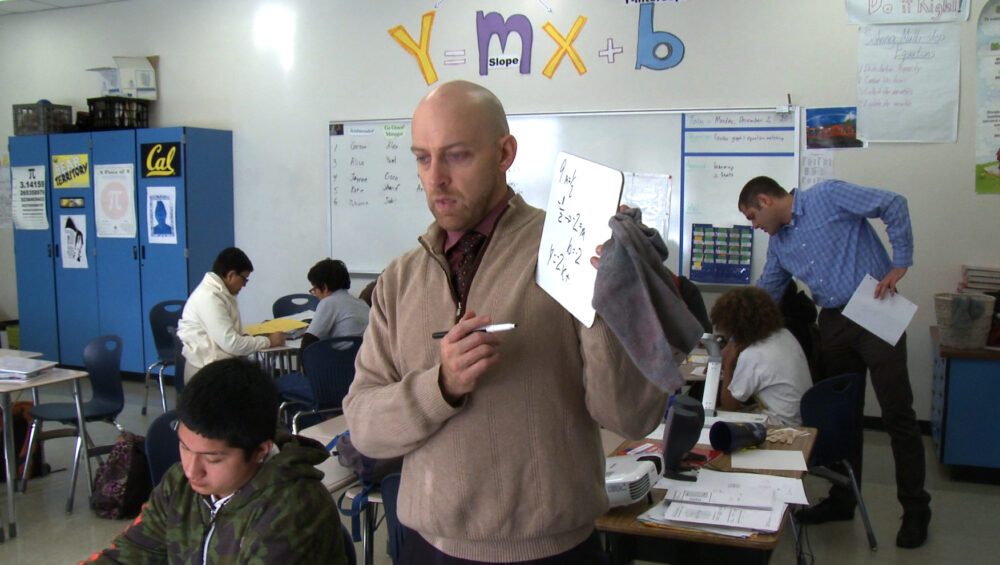Let’s begin with the idea that all (yes, all!) teaching is done with intention. The question becomes: What intention is created? Let’s consider these two classrooms.
Classroom #1
The class of 25 students sits in rows facing the front of the class as one co-teacher gives a lecture as he flips through a visual PowerPoint. The other co-teacher monitors student performance by quietly walking around the room. This teacher is feeling the urge to chime in—to add to an idea, clarify a thought, or guide meaningful connections—but remains quiet because this teacher knows a lot of content must be covered, and the clock is ticking. The bell rings, and some students are given printed PowerPoint slides as notes.
Classroom #2
The class of 25 students sits in rows as class begins. One of the co-teachers begins with a short video to spark students’ attention. After the quick viewing, the other co-teacher asks students to take two minutes to share with a peer sitting near them about their connection with the video. Both teachers listen in on the student exchanges, providing an opportunity to formatively assess students’ understanding. Each teacher jots down quotes or key ideas shared by students to document student performance. Teachers tell the class some ideas heard as they made their way around the room as a way to connect the students to the next phase of learning. Teachers work together to extend students’ content knowledge through a lecture style format, with one teacher sharing the knowledge through visual and auditory modes, and the other teacher chiming in with clarifying ideas and questions. The first teacher models note-taking on the board. The two teachers stop at strategic points to share their thinking and provide a few minutes for students to process the information. All students are offered access to notes by either allowing them to take a picture of the teacher-modeled notes on the board or by taking a note-taking organizer handout. Students have the choice to write, sketch, or highlight key ideas in their notes. All PowerPoint visuals are also available to students on the class website.
How UDL Strengthens Co-Teaching with Intention
Clearly, all teachers in these two classrooms set the necessary intention to guide students to extend their content knowledge. But notice how the process of learning in the second scenario lifted learning to another level. When UDL is part of the intention, teachers place learners at the center. Each co-teacher is an active participant within the instructional process. Each learner in the room has the opportunity to connect and express his or her understanding. The UDL principles move beyond having students passively listen or copy notes by rote manipulation. For educators, UDL moves beyond one co-teacher instructing and the other quietly walking around the room. Each learner in the room is seen, heard, and valued—including the teachers.
-Elizabeth Stein
 Elizabeth Stein is a teaching veteran, with more than 20 years experience spanning grades K-8, specializing in universal design for learning and special education. She’s currently a special education/UDL instructional coach and new-teacher mentor in Long Island NY’s Smithtown Central School District. Elizabeth is National Board Certified in Literacy and a contributor to Education Week and other publications. Her first book Comprehension Lessons for RTI (Grades 3-5), is published by Scholastic (June 2013). She blogs at Two Teachers in the Room for MiddleWeb, LLC. Follow her on Twitter @elizabethlstein
Elizabeth Stein is a teaching veteran, with more than 20 years experience spanning grades K-8, specializing in universal design for learning and special education. She’s currently a special education/UDL instructional coach and new-teacher mentor in Long Island NY’s Smithtown Central School District. Elizabeth is National Board Certified in Literacy and a contributor to Education Week and other publications. Her first book Comprehension Lessons for RTI (Grades 3-5), is published by Scholastic (June 2013). She blogs at Two Teachers in the Room for MiddleWeb, LLC. Follow her on Twitter @elizabethlstein

